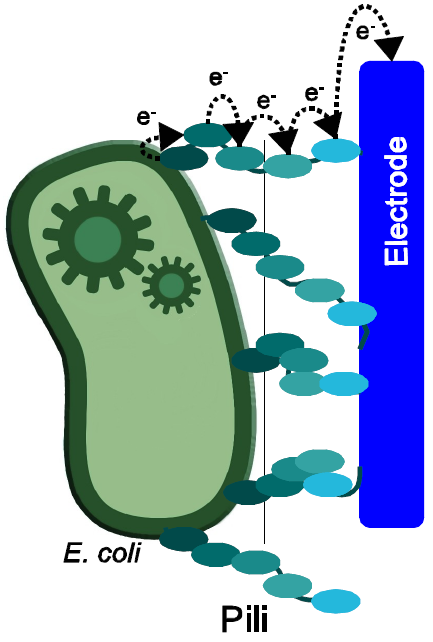Team:Bielefeld-Germany/Project/Nanowires
From 2013.igem.org
| Line 18: | Line 18: | ||
[[Image:Bielefeld-germany-project-overview-nanowires.png|410x350px|center|MFC overview|]] | [[Image:Bielefeld-germany-project-overview-nanowires.png|410x350px|center|MFC overview|]] | ||
<br> | <br> | ||
| + | |||
| + | |||
| + | {{Team:Bielefeld-Germany/Header2}} | ||
| + | {{Team:Bielefeld-Germany/css/header_cleanup.css}} | ||
| + | |||
| + | __NOTOC__ | ||
| + | |||
| + | <html> | ||
| + | |||
| + | <div id="globalwrap"> | ||
| + | |||
| + | <br><br><br> | ||
| + | |||
| + | <div id="leftcol" style="width:600px; height:500px; margin-left:22px; float:left"> | ||
| + | <h2>Mediators</h2> | ||
| + | <p align="justify"> | ||
| + | <font face=""> | ||
| + | |||
| + | |||
| + | Multiple bacteria form special, highly conductive pili, which are required for survival in anaerobe environment. Electrons, which are generated through the oxidation of different substrates, can be transported by these pili and transferred to alternative electron-acceptors, such as sulfur or iron. These so called nanowires could furthermore increase the number of bacteria contacting the surface of the anode. These properties make them another interesting option, regarding the optimization of E. coli for the use in MFCs. | ||
| + | Because several large gene clusters are required to form nanowires in organisms such as ''Geobacter sulfurreducens'', it will be first investigated, whether the existing type 4 pili are suitable for electron conduction by ''E. coli'' as well. | ||
| + | |||
| + | |||
| + | </font> | ||
| + | </p> | ||
| + | |||
| + | </div> | ||
| + | |||
| + | </html> | ||
| + | |||
| + | |||
| + | <div id="rightcol" style="width:320px; height:500px; margin-right:20px; float:right"> | ||
| + | <br><br> | ||
| + | |||
| + | |||
| + | [[Image:Bielefeld-germany-project-overview-nanowires.png|410x350px|center|'''Figure 1:''' placeholder]] | ||
| + | |||
| + | |||
| + | </div> | ||
Revision as of 21:51, 18 September 2013
Nanowires
Multiple bacteria form special, highly conductive pili, which are required for survival in anaerobe environment. Electrons, which are generated through the oxidation of different substrates, can be transported by these pili and transferred to alternative electron-acceptors, such as sulfur or iron. These so called nanowires could furthermore increase the number of bacteria contacting the surface of the anode. These properties make them another interesting option, regarding the optimization of E. coli for the use in MFCs. Because several large gene clusters are required to form nanowires in organisms such as Geobacter sulfurreducens, it will be first investigated, whether the existing type 4 pili are suitable for electron conduction by E. coli as well.
Mediators
Multiple bacteria form special, highly conductive pili, which are required for survival in anaerobe environment. Electrons, which are generated through the oxidation of different substrates, can be transported by these pili and transferred to alternative electron-acceptors, such as sulfur or iron. These so called nanowires could furthermore increase the number of bacteria contacting the surface of the anode. These properties make them another interesting option, regarding the optimization of E. coli for the use in MFCs. Because several large gene clusters are required to form nanowires in organisms such as ''Geobacter sulfurreducens'', it will be first investigated, whether the existing type 4 pili are suitable for electron conduction by ''E. coli'' as well.
 "
"

